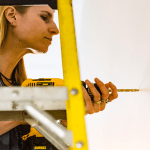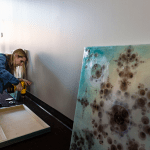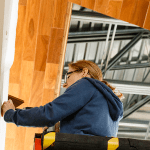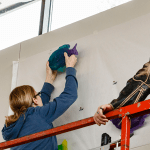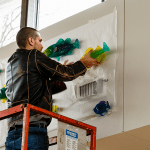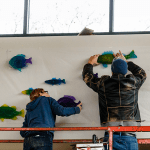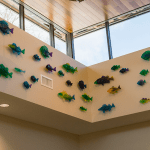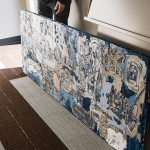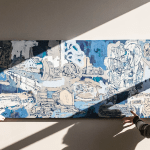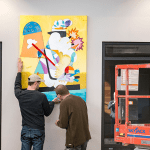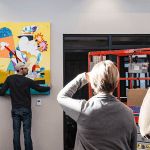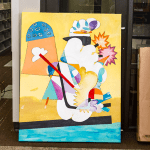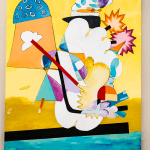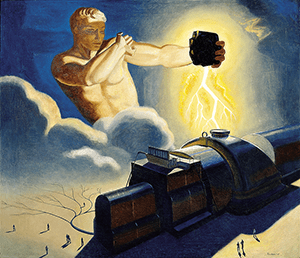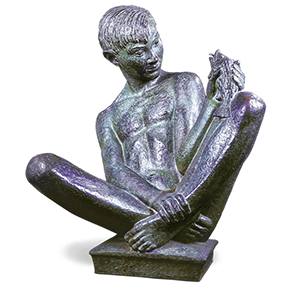Miamisburg
About the Miamisburg Art Installation and Artists
Amy Kollar Anderson, (b.1974), American, MIAMISBURG MANDALA, 2016, Mica, acrylic paint, glitter and pouring medium on birch panel. Collection of the Dayton Metro Library, 2017.1
Dayton artist, Amy Kollar Anderson is known for her surrealistic style and use of unusual materials. In this triptych, Kollar Anderson incorporates mica as a key component referencing the use of mica in the energy industry as well as its importance to the Adena culture, the early inhabitants of what is now Miamisburg.
About the Artist
AMY KOLLAR ANDERSON creates surreal narrative paintings inspired by natural forms, decorative arts and her love of animals. She received her BFA from The School of the Art Institute of Chicago and a Master of Humanities from Wright State University. She lives with her husband and their four cats in Dayton. To learn more please visit: www.kollaranderson.com.

Susan Byrnes (b.1967) American, GREAT MIAMI SCHOOL, 2016, pigmented cast resin, Collection of the Dayton Metro Library, 2017.2
Susan Byrnes is a visual artist, based in Cincinnati, whose studies in photography, sculpture and sound inspire an interdisciplinary practice that encompasses traditional and contemporary forms and methods. This large scale work is comprised of 60 multicolored cast resin fish, representing three types of fish found in the Great Miami River. Referencing the fish held by Huck Finn in the Koepnick work, Byrnes’ work plays on our sense of delight with nature as well as connecting visitors to the nearby Great Miami River.
About the Artist
SUSAN BYRNES is a visual artist whose work encompasses traditional and contemporary forms and practices, including sculpture, multimedia installation, radio broadcasts, writing, and curatorial projects. Her art has been exhibited in galleries and museums throughout the United States. Susan serves as an artist in the Ohio Arts Council Arts Learning Artist in Residence Program. She is the recipient of a Cincinnati Art Ambassador Fellowship and a Montgomery County Arts and Culture District Individual Artist Grant. She earned an MFA from Eastern Michigan University and a BFA from Syracuse University. Susan resides in Cincinnati, Ohio. For more information please visit: www.susanbstudio.com.

Mychaelyn Michalec, (b.1977), American, FROM THE RIVER TO THE STARS, 2016, acrylic on canvas, Collection of the Dayton Metro Library, 2017.4
Dayton artist Mychaelyn Michalec generally works autobiographically with themes that center on domestic life, memory, repression, and loss. In this large scale work, Michalec departs from the autobiographical and focuses on key industries in the history of Miamisburg. Referencing the work of Rockwell Kent, Michalec depicts the importance of energy to Miamisburg’s history from water to electric to atomic, which contributed to the industry and vibrancy of the city.
About the Artist
MYCHAELYN MICHALEC is an artist who lives and works in Dayton, Ohio. Her work is an autobiographical narrative about domestic life, memory, repression, and loss. Mychaelyn has degrees in painting and art history as well as a degree in Library Sciences. Michalec likens memories to painting; “you fill in the gaps and you try to clarify or obscure some things”. For her, viewing a painting is like visiting a memory, the interpretation is dependent on your perspective and influenced by previous experience. For more information please visit: http://www.mychaelynmichalec.com/.

Darren Haper (b. 1974) American, DREAM CHASERS, 2016, Acrylic on canvas, Collection of the Dayton Metro Library, 2017.3
Miamisburg artist Darren Haper fuses pop culture ideas, child-like whimsical imagery, and often abstracted cartoon characters into large boldly colored canvases. Haper states that much of his inspiration comes from watching the free flow of ideas his children express, which he combines with formal elements and a variety of textures.
About the Artist
DARREN HAPER'S work has been exhibited in numerous solo and group exhibitions, including the national publication New American Paintings. In 2015 he was named “artist to watch” at Dayton Visual Art Center. He has had solo exhibitions at Green Line Projects, Philadelphia, PA; Divisible, Dayton, OH; Wittenberg University, Springfield, OH; and Cochran Gallery; Dayton, as well as many group exhibitions. Darren received a BFA in painting from Miami University and currently lives in Miamisburg, Ohio with his wife and two young children. For more information please visit: http://www.darrenhaper.com.

The Stories Behind the Miamisburg Art Inspiration
From the Collection of the Dayton Art Institute
Rockwell Kent (1882-1971) American, Endless Energy for Limitless Living, 1945-1946, Oil on canvas. 44 x 48 inches. The Dayton Art Institute, Gift of Dane and Kerry Dicke, 1994.60
Brandishing a large lump of coal, a male figure emerges from a burst of clouds. The coal produces an explosive ray of light that beams down on a generator causing the man to shield his eyes. Rockwell Kent painted this work for the Bituminous Coal Institute as part of an ad campaign intended to boost the reputation of the coal industry and promote the centrality of this energy source for the modern, postwar society. Kent’s composition depicts the vital role of man in the transformation of coal into energy.
Rationale for inclusion: Energy is an important part of Miamisburg’s history – from the long operation of its’ own coal power plant to the Mound atomic energy plant. Today the historic city remains vibrant because of the energy behind downtown revitalization and other economic development initiatives. The Library contributes to that energy and vibrancy as a powerhouse of resources to inform, inspire and enrich the community.
View this artwork and learn more by clicking here, opens a new window or visit The Dayton Art Institute.
Robert Koepnick (1907- 1995) American, Huck Finn, c. 1930, Bronze, 28 3/4 x 22 1/2 x 22 inches. The Dayton Art Institute, Gift of Mrs. Herbert Hook in memory of her brother Mr. William C. Sherman, 1949.4
Robert Koepnick created many sculptures to adorn Dayton’s most prominent businesses, government buildings, and homes. A lifelong resident of the greater Dayton area, Koepnick left a lasting mark on this city. Although Huck Finn now resides at The Dayton Art Institute, this bronze originally earned its keep in a private home, spouting water from atop a marble pedestal!
Rationale for inclusion: This sculpture is based on one of the most loved – and most banned – books in American history reminding us of the central role libraries play in making books accessible to all. It also reminds us of the love Miamisburg has for its riverfront and the activities it provides for the community.
View this artwork and learn more by clicking here, opens a new window or visit The Dayton Art Institute.
How did these pieces inspired our artists?
“The powerful imagery in Rockwell Kent’s painting inspired me to explore Miamisburg’s legacy in the Energy industry, which uses mica for its unique electrical and thermal properties. The Adena/Hopewell Culture, the early inhabitants of the Miamisburg area and the creators of the Miamisburg Mound, carved mica for ceremonies and personal adornment, so I choose to use circular mica in this artwork to represent the sacred circle of the Miamisburg Mound.” Amy Kollar Anderson, artist
“Great Miami School features bluegill, largemouth bass and walleye, all found in the nearby Great Miami River. This piece was inspired by the proximity of the library to the river and its aquatic life, the importance of the library to local schoolchildren, and the fish in the DAI’s 1930 Huck Finn sculpture by Robert Koepnick.” Susan Byrnes, artist
“The Story of Huckleberry Finn and Tom Sawyer rafting down the Mississippi river in search of adventure sparked the abstracted depiction of that event in my painting. While mostly abstract, representational elements are included. The bright colors and movement represent the energy and creativity of youth while also capturing an adventurous spirit.” Darren Haper, artist
“Like the Rockwell Kent work, I created a piece that emphasizes the important role of energy in Miamisburg’s past as well as its future. This work uses the ghostly images of historic slides and photographs to create an abstract image timeline. Some of the images include aerial views of Miamisburg, the locks on the canal, the first electric street car, the first water and electric plant, aerial views of Mound Labs, equipment used at Mound Labs, and the Cassini satellite.” Mychaelyn Michalec, artist
Thank you to our partner,
the Dayton Art Institute, opens a new window.
Photos of ReImagining Works pieces taken by Andy Snow.

